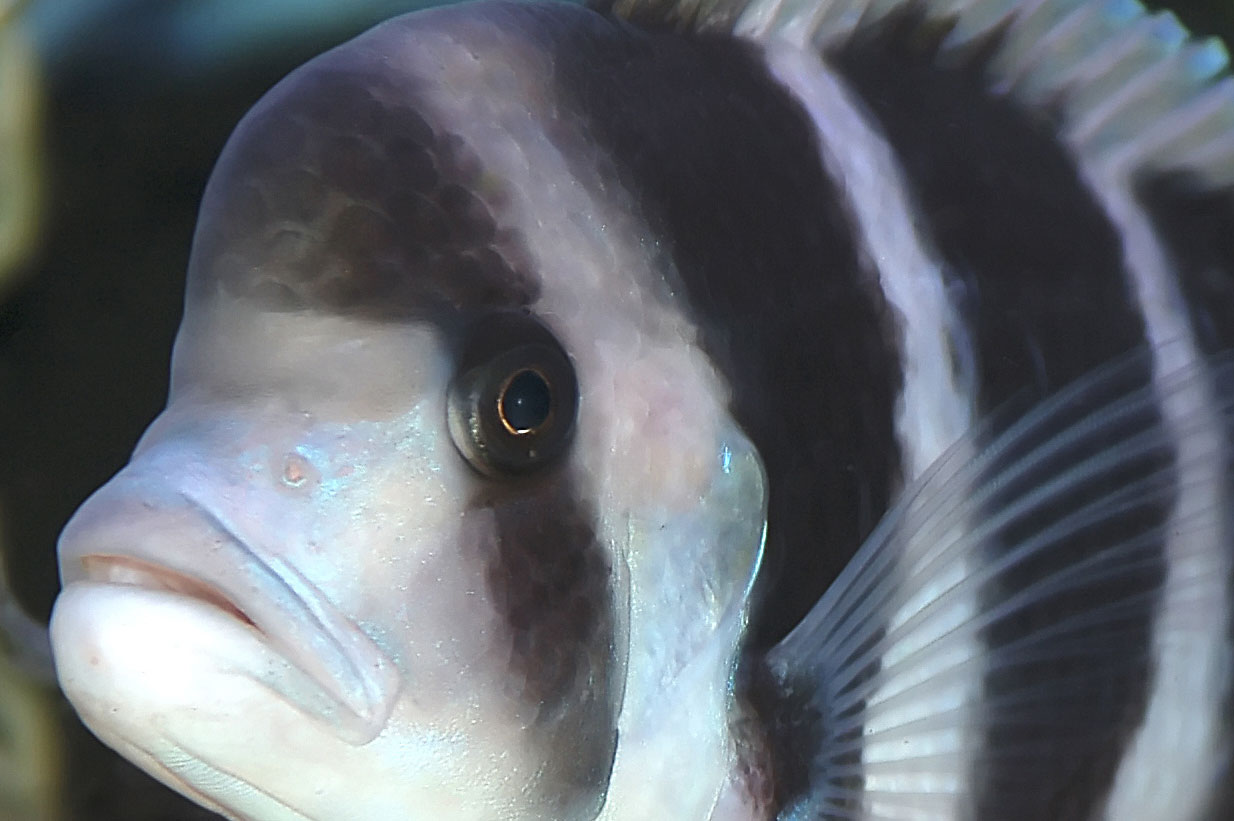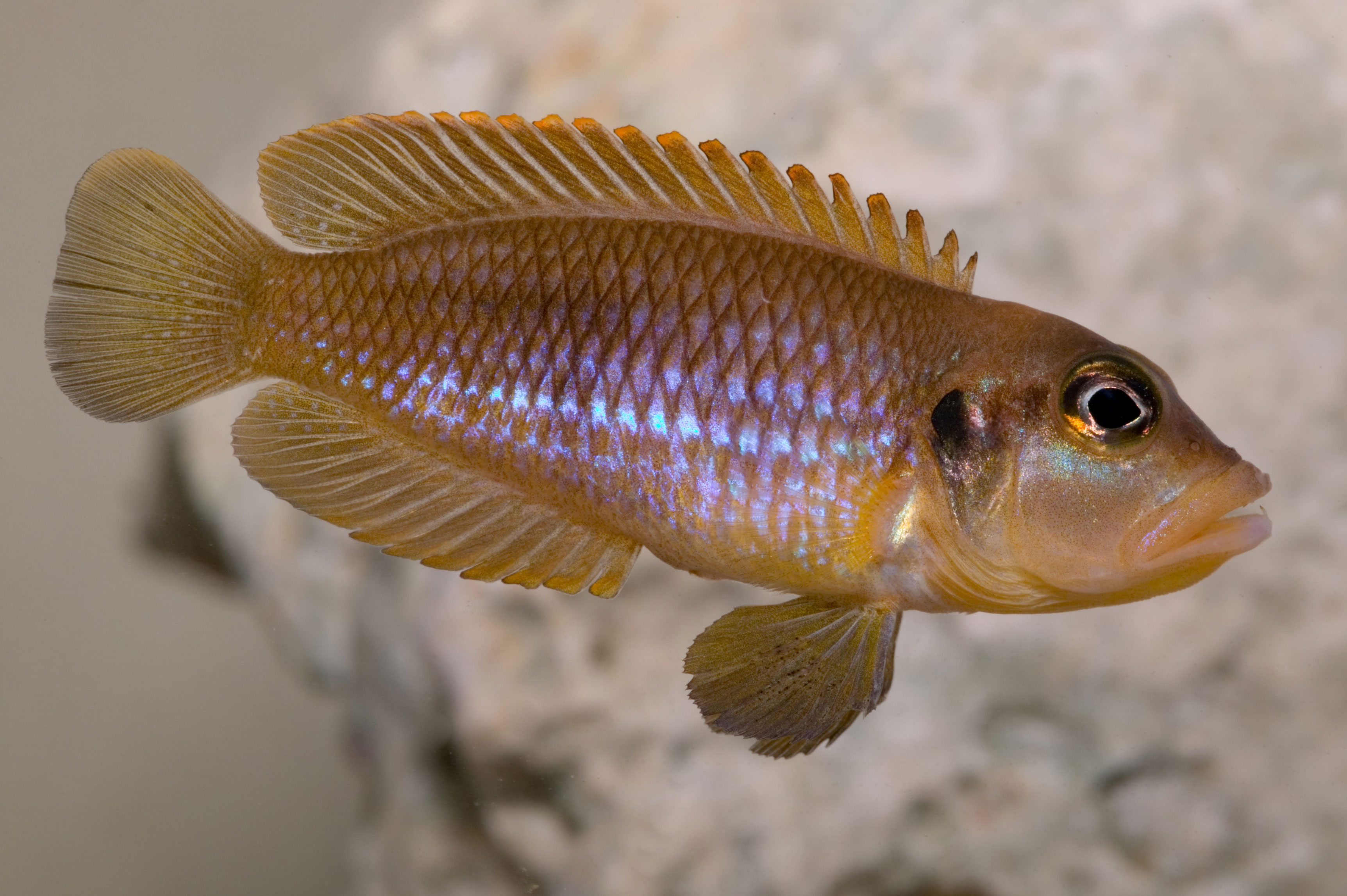Lake Tanganyika
In almost all fresh-water areas of the earth the calcium content is clearly higher than the magnesium content. This limits the pH-value increasing even by higher carbonate hardness, because from a pH-value of 8.5 to 9 calcium carbonate (lime) begins to solidify out and in this process limits the further increase of the pH-value.
In Lake Tanganyika there is however 4-times more magnesium as calcium in soluble form (considered as a mole fraction, almost 6-times as much). Because magnesium carbonate begins only first with a pH-value far above 9.5 - 10 to solidify, it means there is almost nothing being down to limit the rise of the pH-value above 9.
So it is really important, through suitable technical measures (intensive aeration, trickle filter to sink the CO2-content, adequate exchange of water to stabilize CH), to hold if possible the pH-value stable over 8, because from experience lower pH-values than this through the effects of the ever increasing by-products of feeding and too much free CO2 are not tolerated well, by animals such as these.


But not every hard and mineral substance rich water is automatically perfectly for cichlids from Lake Tanganyika, because of this and also by the application of reverse osmosis water (e.g. because of unsuitable origin water, too much nitrate, phosphate etc) it is necessary to harden the water further using hardening salt mixtures like Duradrakon T TH-Plus and Duradrakon CH-Plus.
Application and Dosage
There is on anion side apart from a little chloride and almost unmeasurable sulfate, practically speaking just hydrogen carbonate in the water from the sea. When one would attempt to directly simulate this water composition, then one must include heavily soluble magnesium and calcium carbonates as constituents of the hardening salt mixture.
These salts would however (for these alkaline targeted pH-values), not dissolve within an acceptable period of time.
The way out is the conception of a 2-component mixture:
Duradrakon CH-Plus for the (hydrogen) carbonates in an easily soluble form
Duradrakon T TH-Plus for the associated Cations also in an easily soluble form
In this manner one can reach the desired pH-value and the desired hardness with only a slightly increased complete salt content.
Phosphate and nitrate must not be added, although they are present in sea water. They are more than adequately created anyway, in a pool containing fish. It is similarly true also for the iron content; this can be enhanced if required however by the use of a good water-plant fertilizer.
With these pre-requisites the following dosages emerge:
| Existing Hardness [°dH CH as well as TH] |
Duradrakon CH-Plus (Carbonates - CH) |
Duradrakon T TH-Plus (Alkaline Earth Ions - TH) |
| 0 | 29.9 g / 50 l | 17.8 g / 50 l |
| 1 | 28.2 g / 50 l | 16.2 g / 50 l |
| 2 | 26.5 g / 50 l | 14.6 g / 50 l |
| 3 | 24.8 g / 50 l | 13.1 g / 50 l |
| 4 | 23,1 g / 50 l | 11.5 g / 50 l |
| 5 | 21,4 g / 50 l | 9.9 g / 50 l |
| 6 | 19.7 g / 50 l | 8.3 g / 50 l |
| 7 | 18.0 g / 50 l | 6.7 g / 50 l |
| 8 | 16.3 g / 50 l | 5.1 g / 50 l |
| 9 | 14.6 g / 50 l | 3.5 g / 50 l |
| 10 | 12.9 g / 50 l | 1.9 g / 50 l |
| 11 | 11.2 g / 50 l | 0.3 g / 50 l |
| 12 | 9.5 g / 50 l | 0.0 g / 50 l |
| 13 | 7.8 g / 50 l | … |
| 14 | 6.1 g / 50 l | … |
| 15 | 4.4 g / 50 l | … |
| 16 | 2.7 g / 50 l | … |
| 17 | 1.0 g / 50 l | … |
| > 17 | 0.0 g / 50 l | … |
In other words, one requires 1.5 g of Duradrakon CH-Plus per 50 l water in order to increase CH by 1°, as well as 1.7 g of Duradrakon T TH-Plus per 50 l water in order to increase TH by 1°.
Both mixtures must be dissolved separately from one-another and should only be mixed together directly before being added into the aquarium. This should if possible take place in a diluted form, in order to avoid the appearance of cloudy water in the form of un-dissolved calcium and magnesium carbonates.
Duradrakon CH-Plus is in its pure form relatively alkaline and so long contact with the human skin or mucus membranes (like the eyes!) should be avoided. If in doubt, flush using as much water as possible. Also please avoid breathing in the dust.
But also be careful of Duradrakon T TH-Plus that can also irritate the human skin if contact occurs.
Analyses of the Lake Water
Dr. Kuferath - member of the Belgium research team in 1946/47, from “Atlas der Tanganjikasee-Cichliden”, vol. 1 from Pierre Brichard:
| Salt | Amount [mg/l] |
| Sodium carbonate, Na2CO3 | 125 |
| Potassium chloride, KCl | 59 |
| Potassium nitrate, KNO3 | 0.5 |
| Lithium carbonate, Li2CO3 | 4 |
| Sodium sulfate, Na2SO4 | 1 |
| Calcium carbonate, CaCO3 | 30 |
| Magnesium carbonate, MgCO3 | 144 |
| Aluminium sulfate, Al2(SO4)3 · 18 H2O | 5 |
| Potassium sulfate, K2SO4 | 4 |
| Iron (III) chloride, FeCl3 · 6 H2O | 0.5 |
| Sodium phosphate, Na3PO4 · 12 H2O | 0.4 |
| Sodium silicate, Na2SiO3 | 13.5 |
From this one can calculate:
| Cations | Amount [mg/l] | Anions | Amount [mg/l] |
| Sodium, Na+ | 60.12 | Carbonate, CO3- | 194.50 |
| Potassium, K+ | 32.93 | Chloride, Cl- | 28.26 |
| Calcium, Ca2+ | 12.01 | Nitrate, NO3- | 0.31 |
| Magnesium, Mg2+ | 41.51 | Phosphate, PO43- | 0.10 |
| Aluminium, Al3+ | 0.40 | Silicate, SiO32- | 8.50 |
| Lithium, Li+ | 0.75 | Sulfate, SO42- | 5.10 |
| Iron, Fe2+/3+ | 0.10 |
Especially conspicuous are the iron content values of 0.1 mg/l and a really high value of 8.45 mg/l silicate. Aluminum and lithium are also present in clearly larger amounts than is normal.
Pierre-Denis Plisnier - his later (1993 - 1995) analysis from the southern end of the lake by Mupulungu extensively confirms the older analysis (Pierre-Denis Plisnier, DATZ (1998) 51(9), 594):
| Value [unit] | in 1 m depth | in 100 m depth |
| Conductivity by 25 °C [µS/cm] | 646 | 668 |
| pH | 9.02 | 8.90 |
| Alkalinity [meq/l] = CH [° dH] = Carbonat, CO32- [mg/l] |
6.3 17.6 190.1 |
6.4 17.9 193.1 |
| Nitrat-N [µg/l] = Nitrate, NO3- [mg/l] |
60 0.27 |
100 0.45 |
| Nitrite-N [µg/l] | 3 | 4 |
| Ammonium-N [µg/l] | 0 | 0 |
| Soluble reactive Phosphor [µg/l] = Phosphate, PO43- [mg/l] |
10 0.03 |
30 0.09 |
| SiO2 [mg/l] = Silicate, SiO32- [mg/l] |
1.0 1.27 |
1.7 2.16 |
| Sodium, Na+ [mg/l] | 63.9 | 65.9 |
| Potassium, K+ [mg/l] | 33.0 | 33.3 |
| Calcium, Ca2+ [mg/l] | 11.6 | 12.0 |
| Magnesium, Mg2+ [mg/l] | 41.6 | 42.3 |
| Sum alkaline earths (Ca + Mg) [mmol/l] = TH [° dH] |
2.00 11.2 |
2.04 11.4 |
| Chloride, Cl- [mg/l] | 38.1 | 38.5 |
| Sulfate, SO42- [mg/l] | 0.8 | 0.9 |
For aluminium and lithium there are no new data. The strongest deviations can be seen for sulfate and silicate components; here the later values lie significantly lower, but by chloride content the value lies correspondingly higher.

